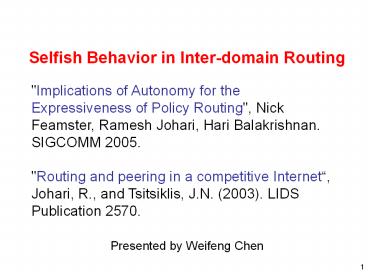Selfish Behavior in Interdomain Routing - PowerPoint PPT Presentation
Title:
Selfish Behavior in Interdomain Routing
Description:
'Routing and peering in a competitive Internet', Johari, R., and Tsitsiklis, J.N. (2003) ... Cogent. MIT. Expressiveness: ASes can achieve objectives ... – PowerPoint PPT presentation
Number of Views:34
Avg rating:3.0/5.0
Title: Selfish Behavior in Interdomain Routing
1
Selfish Behavior in Inter-domain Routing
"Implications of Autonomy for the Expressiveness
of Policy Routing", Nick Feamster, Ramesh Johari,
Hari Balakrishnan. SIGCOMM 2005. "Routing and
peering in a competitive Internet, Johari, R.,
and Tsitsiklis, J.N. (2003). LIDS Publication
2570.
- Presented by Weifeng Chen
2
Implications of Autonomy for the Expressiveness
of Policy Routing
- Nick Feamster, MIT
- Ramesh Johari, Stanford
- Hari Balakrishnan, MIT
3
Internet Routing is Policy-Based
Abilene
Comcast
MIT
ATT
Cogent
Expressiveness ASes can achieve
objectivesAutonomy ASes can configure policies
independently
Expressiveness vs. autonomy
4
Talk Outline
- Background
- Expressiveness ranking and filtering
- Autonomy independent ASes
- Stability and Safety
- Filtering advertise paths to other AS
- Ranking and safety
- Dispute rings and safety
- Autonomy and safety
5
Expressiveness Ranking and Filtering
Ranking route selection
Customer
Primary
Competitor
Backup
Ranking controls traffic out of the network
traffic engineering Filtering controls
traffic into the network business contracts
Must have autonomy!
6
Preferred and consistent paths
- Routing system
- Paths from ASes to common destination 0
- Preference a total order
- Prefer P to Q
- Feasible specified by filtering
- Consistent paths aligned with feasibility
- E.g, if ijP0 is a path from i to 0, then P must
be a feasible path from j to 0
7
Stable and safe routing system
- Discrete activation of AS
- Single AS at each time step
- Process all incoming advertisement and make
decision - Stable
- All paths are preferred
- Safe
- The routing paths do not oscillating when ASes
activate, given any initial path assignment
Under ranking and filtering, with autonomy
8
Goal Local Constraints for Safety
Given no restrictions on filtering or topology,
what are the local restrictions on rankings to
guarantee global safety under filtering?
9
Safety No Persistent Oscillation
Depends on the interactions of rankings and
filters of multiple ASes
1 3 0 1 0
0
2 1 0 2 0
3 2 0 3 0
Dispute wheel global, cyclic relationship among
rankings
Varadhan, Govindan, Estrin, Persistent Route
Oscillations in Interdomain Routing, 1996
Griffin, Shepherd, Wilfong, The Stable Paths
Problem and Interdomain Routing, ToN, 2002
10
Contribution 1
- Next-hop ranking
- Preference only depends on next hop
- Known result If no filtering, using next-hop
ranking, there exists a stable path assignments - New results
- A routing system where each node has only a
next-hop ranking may not be safe - Introducing filtering can yield a system where no
stable path assignment exists
11
Example
3,0,2
Filter 3 from 2
0
Filter 1 from 3
Filter 2 from 1
1,0,3
2,0,1
12
Contribution 2 First Necessary Condition for
Safety
- Known result No dispute wheel ? Safe
Safe
No Dispute Ring
- New result
- No dispute wheel? Safe under filtering
- Dispute ring implies no safety under filtering
Safe under Filtering
No Dispute Wheel
Dispute ring Dispute wheel where each node only
appears once
Problem No dispute ring is still a global
condition.
13
Contribution 3 Autonomous
- Providing complete autonomy and filtering,
shortest paths ranking guarantee safety
ARC Function
Rankings (from single AS)
Accept/Reject
14
ARC Function Properties
Permutation Invariance Node labels dont matter
ARC Function
Accept
Accept
Scale Invariance
Adding new nodes does not force a node to change
its rankings over old paths.
15
Examples of ARC Functions
- Accept only next-hop rankings
- Captures most routing policies
- Problem system may not be safe
- (See Section 4.1 for proof)
- Accept only shortest hop count rankings
- Guarantees safety under filtering
- Problem not expressive
16
What ARC Functions Violate Safety?
Theorem. Permitting paths of length n2 over
paths of length n will violate safety under
filtering. Theorem. Permitting paths of length
n1 over paths of length n will result in a
dispute wheel.
17
Conclusion
- Factoring expressiveness ranking and filtering
- Dispute Ring First necessary condition for
safety - ARC Function Abstraction for autonomy
- Restrictions on rankings that guarantee safety
and preserve autonomy
18
Routing and Peering in a Competitive Internet
- Ramesh Johari, MIT
- John Tsitsiklis, MIT
19
Growth of Internet
- Before 1995
- Maintained and directed by government and
academia - Overall performance best interested of all
parties - But after 1995
- Loosely federation of independent network
providers - Individual objectives not necessarily aligned
- Self interested behavior to maximize own profits
Goal Understand economic incentives driving
actions of network providers
20
Nearest exit in peer networks
- Peer networks B will only accept traffic from A
that is destined for points within B, and vice
versa. - Cost only network routing costs
- Nearest exit or hot potato outgoing traffic
exits a provider's network as quickly as possible
21
Optimal replacement of interconnection
- Under nearest exit routing, where two peer
networks choose to interconnect?
- NP-complete in general
- Sender find a set of interconnecting points that
minimize the cost of sending traffic to the
receiver network - Special cases (sender and receiver have a linear
or tree topology), there exists a unique peering
point placement which will simultaneously satisfy
both
22
Nearest exit vs. Optimal Routing
- Providing interconnection replacement, nearest
exit routing is not optimal, according to a
priori network cost metric - But if network cost is measured by assessing a
cost per unit flow traversing each link, then
cost using nearest exit is no worse than three
times the optimal (shortest path)































